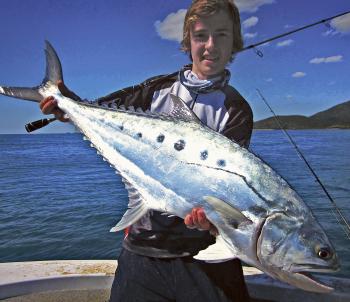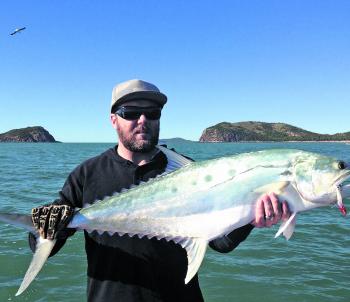Queenfish – one of the most exciting fish around have hit the Capricorn Coast and in numbers we haven’t seen for a long time!
The queens along the front wall at Rosslyn Bay Harbour were out to chase the many bait schools that were attempting to get to shelter inside among the structures. Ironpot has had a few large shows of queenies working the rubble patch points on the northern side where the light gear crew are having a field day with poppers, chromies, plastics, and small minnows. They congregate in big schools among the many bommies and rock features, particularly at the mouth of Corio Bay and up through the mulloway hole. These huge queenies will smash anything thrown in their direction. Drift past the bommies, throw your lures into the wash and retrieve as fast as you can. If the queens are there you will find out immediately when 50 odd fish try to snatch your lure at once. And it doesn’t take long for one of them to find the hooks!
Corio has a lot of spots that hold queenies of different sizes to suit the tackle you prefer. You’ll find the midsize fish right along the inside of the northern headland away from the big fellas that stay in the deeper waters. These fish head up around the mangroves and rocky bays feeding on the greenback herrings that live there all the time. Some of the local guys flick out an unweighted herring on ultra light gear and get some great entertainment for their effort. The smaller fish head up the bay to places like Deep Creek. The shallow channels that run between sandbanks funnel the baits through a small area and naturally the predators are there to meet them. The Keppels have a few areas where queenies are a regular feature – Wreck Beach is one such area. This is my favourite spot for land based action that rarely fails to deliver as the fish move up and back from headland to headland smashing the hardyheads and herring schools.
As usual red emperor and nannies are featuring heavily in local reef captures. The conditions expected in October should give us plenty of chances to get out amongst them. For much of the year the wider grounds seem to fish the best but over the next month or so the closer grounds can produce quality fish. The bait grounds out behind the main islands such as Greasy Alley and The Cod hole have had some very nice nannies whenever the yakkas are there. The red fern country starts around the 40m contour lines and goes all the way out wide. This is the home of the extra large red fishes, rosy job fish and snapper which seem to hang with the other schools of big fish in the deeper grounds.
Squid, pillies and flesh strips are the popular baits to throw. Micro jigging deep water jigs has taken off here like everywhere else and has definitely added to the local captures. The tides can turn the bite on and off and for us the run in up to high and the start down is best in the mid range depths. The real deep spots further out go well towards any tide change as long as there is some run. The secret to getting the bigger fish is locating areas that other boats don’t know about or don’t get to very often. We find that the contours on your charts are as good a place to look for new ground as any.
The biggest tip is to watch the sounder. Sometimes those little changes in depth or a school of bait can lead you to the spot of your dreams. Unless you have a camera on board with a long enough tether to reach the bottom in the 50m range you don’t really know what you are looking at despite having all the best in sonar gear. That means us average guys should double check anything that looks different to the surrounding area. In recent times one of our regular offsiders with a keen eye has found ground not much bigger than an average lounge room that has held trophy reds or nannies and even big blue spot coral trout.
Many of the mackerel species have come in quantity and the run should continue from now until after Christmas. Doggies, spotties, and Spanish follow the schools of baitfish and hang around the area long enough to fatten up before travelling up or down the coast. When the tides are small, Barren, Outer, Man and Wife and Conical are spots that work well for Spanish and when the tides are up places such as Liza Jane, Manifold, Flat and Perforated are hard to better. Spotties and doggies congregate at all the inshore reefs and even the rock walls around Rosslyn Bay Harbour whenever the weather drops out.
The estuary grunter captures have increased pretty well with the warming of the water and the quantities of small bait fish all around the local systems. The Fitzroy is the home for large grunter whenever they are on. Connors Creek, Port Alma, Devils Elbow, and the bends down from Nerrimbera are all firing. Coorooman Creek, the Causeway Lake and Waterpark Creek have grunter runs that can compete with the river in the size of fish but not in numbers. The popular baits of late have been prawns, fresh fillet strips and greenback herrings. Lately lots of grunter hunters have expanded their tactics by using blades. The small varieties around 40mm are working very well. Gold and chrome seem to be the most popular colours. The trick is to keep contact with the jig the majority of grunter strikes occur as you lower the blade to the bottom between twitches.
I have to mention that October signals the yearly run of juvenile black mulloway. These guys are in the 250-300mm class and often get mistaken for river or soapy mulloway. The Corbetts and Kellys Landing stretch of Waterpark Creek are notable hot spots but they do have a run up the Fitzroy and Coorooman Creek.
Black Mulloway have two rows of spots or blotches along the dorsal fin and the tail with some small spots on the lateral line and look just like a mini mulloway whereas river mulloway or perch have a nose similar to a salmon. They are subject to size regulations and you will be fined if found in possession of undersized black mulloway.
Barramundi have come back into form around the area. The Fitzroy River is the best location for those targeting barras because of the huge amount of country and the diversity of structures found in the river. There are stacks of spots where the river can be accessed from local roads, and wharves that hold plenty of barramundi. From the middle of Rocky down to the delta you’ll find first class barramundi. Just like all other forms of fishing, barramundi have way more choices in the style and type of lures they prefer on any given day. From plastic vibes to hardbodied minnows and poppers a great amount of variety finds its way into a barra kit.
To keep it simple for me I divide the country into areas that I get the most success from. We use hardbodies in tight deep timber and along walls while vibes are the go to in the deeper channels or straight up and down rock faces. Poppers work better just on dark when the barras are moving onto the banks, and up near the surface around the structures.
Reads: 1200
Connor Duffy with a fine local queenie

Zane Lanesbury with a Keppel Bay queenie

Mark Thompson caught this coral trout off the Capricorn Coast




